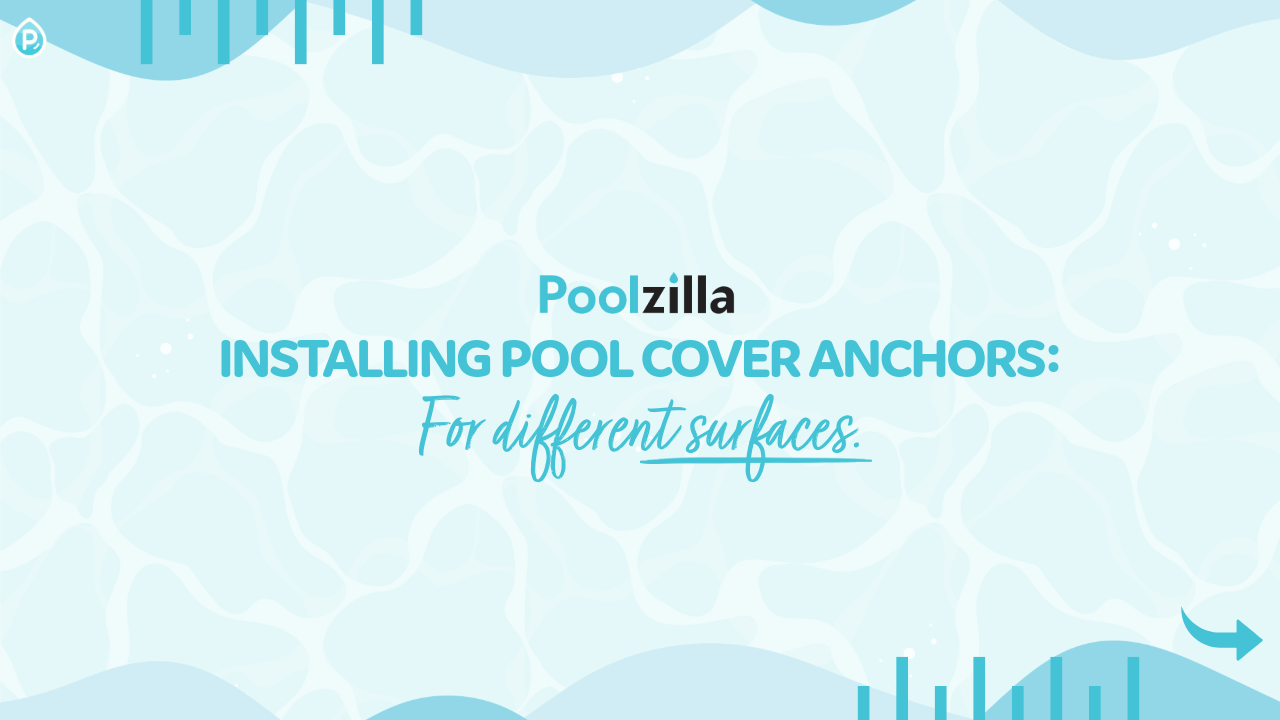
Let’s take a closer look at the different models of cover anchors: the types available, and how to install your chosen anchor to ensure your pool cover stays secure year-round.
NOTE: Instructions applicable to Poolzilla Models, you may want to confirm the dimensions with the manufacturer for your specific anchor model; just to be sure they align with your setup.
Types of Pool Cover Anchors
-
Concrete Anchors: These are designed for concrete decks, they sit flush with the surface when out of use. Once installed; simply use a hex wrench or key to pop them in and out for the seasons.

1. Identify and mark the locations around the pool perimeter where the anchors will be installed, spaced for your safety cover.
2. Use a rotary hammer drill equipped with a ¾” masonry bit. For best results, use a new bit to ensure a clean installation. While drilling, hold the drill firmly and ensure the hole is being drilled vertically.
3. After drilling the length of the anchor body, remove excess concrete dust from the holes using a hose or blower to ensure a secure fit.
4. Insert the anchors into the cleaned holes with a tamping tool and a rubber mallet to gently tap the anchors into place. Be careful not to damage the anchor’s rim during this process.
-
Wood Anchors: Made for wooden decks, these also will sit flush with the surface when out of use. Featuring a wide flange that enhances their stability, ensuring they stay fastened to the wood.

Create a counter-sink hole approximately 1 ½ inch in diameter and ⅜ inch deep to prevent the anchor flange from becoming a tripping hazard.
Next, use a standard ¾ inch drill bit for the center of your counter-sink hole—either a spade bit or an auger bit for a cleaner finish. Ensure that you drill as straight as possible into the wood.
Once the hole is prepared and the anchor is positioned, use the included screws to secure the anchor into place.
Position the provided flange on top of the anchor and tighten the bolt to secure the collar firmly.
-
Paver Anchors: Other anchor designs are not suited to pavers, these aluminum tubes are designed with safety in mind. The wider base that the rod provides ensures security, and can be purchased with and without pre-installed anchors.

1. Measure and mark where each anchor will be installed.
- Install stakes into the joints where stones meet on an interlock or paver deck: while you 100% can install directly through the stones, doing so may cause cracking, especially if the stake enters at an angle, which can put pressure on the stone and cause chipping or shifting.
- When installing in grout joints, some movement of the stones may break the grout, which is normal. Re-sanding will help minimize the appearance of shifted stones.
2. Using a drill with a 7/8'' drill bit, create holes at the marked locations. Ensure each hole is deep enough to fully accommodate the length of the aluminum tube anchor (depth will vary based on size)
- Core drill bits are designed for a cleaner install, use a broom or vacuum to clean up any excess dust.
3. Place the aluminum tube anchors into the drilled holes. Use a tamping tool and a soft hammer to gently tap the top of the tubes, ensuring they are securely seated.
4. Once the anchors are flush with the deck, twist the anchor screws into the tops of the tubes.
5. After all anchors are installed, verify that each one is stable and does not wobble.
-
Wall Anchors: Designed to be installed on the walls surrounding the pool, these anchors are designed to remain in place year-round, seamlessly blending with most surfaces while providing reliable cover security.

1. Take a standard 3/8" drill bit and drill into the side wall. Drill deep enough so that the anchor can sit flush to the surface. Be careful to drill as straight as possible into the wall. Be mindful of any piping to ensure you do not drill into it.
2. Once the hole is drilled, you can take the end of the anchor and begin tamping it into the hole. We recommend using a mallet and a tamping tool to properly insert the anchor. Make sure the anchor sits flush so part of the screw is not hanging out of the hole.
3. Take the provided washer for the anchor and place it over the screw. Twist the anchor into place until it is locked in and tight.
4. The wall anchor should be ready to be used at this stage. You can attach the wire to the hook. Wall anchors will stay in place year-round and blend very well with most surfaces.
Selecting the appropriate pool cover anchor is essential to ensure your cover stays securely in place, and to protect your pool year-round.
Always adhere to product guidelines.
Happy swimming!

